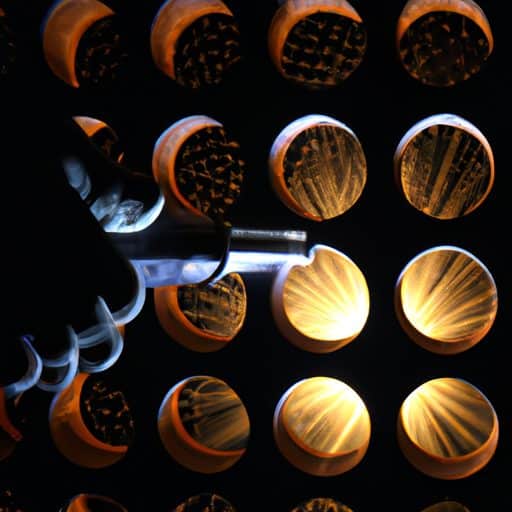Gas Metal Arc Welding (GMAW) proves to be an exceptional technique for high deposition rate welding, offering numerous advantages that make it a preferred choice in the welding industry. With its ability to produce high-quality, efficient welds at a faster rate than other methods, GMAW ensures increased productivity and reduced project timelines. Its versatility allows for the welding of various materials, including carbon steel, stainless steel, and aluminum, making it suitable for a wide range of applications. Additionally, the use of shielding gas provides excellent protection against atmospheric contamination, resulting in cleaner, stronger welds. As we explore the advantages of using GMAW for high deposition rate welding, we uncover a technique that emphasizes efficiency, quality, and versatility, revolutionizing the way we approach welding projects.
Review contents
Advantages of Gas Metal Arc Welding (GMAW) for High Deposition Rate Welding
Gas Metal Arc Welding (GMAW), also known as MIG welding, is a versatile and efficient welding process that offers numerous advantages for high deposition rate welding. From increased productivity to reduced heat input for sensitive materials, GMAW provides a wide range of benefits that make it a preferred choice for many welding applications.
Increased productivity
One of the significant advantages of GMAW for high deposition rate welding is its ability to increase productivity. With its high welding speeds and continuous wire feeding, GMAW allows for faster completion of welds compared to other welding processes. This efficiency helps to shorten project timelines and improve overall productivity, making it an ideal choice for industries that require quick turnaround times.
High deposition rates
GMAW is renowned for its high deposition rates, making it a preferred choice for high volume welding applications. The process involves the continuous feeding of a consumable wire electrode, which melts and joins the base metal, resulting in rapid and efficient welds. This high deposition rate allows for the creation of strong, durable welds in a shorter amount of time, contributing to increased productivity and cost-effectiveness.
Versatility in materials
Another advantage of GMAW for high deposition rate welding is its versatility in working with various materials. Whether it’s mild steel, stainless steel, aluminum, or other alloys, GMAW can weld a wide range of materials. This versatility makes it a valuable welding process for industries that deal with multiple material types and compositions, providing a flexible and efficient solution for diverse welding applications.
Less distortion
GMAW helps to minimize distortion in the welded workpiece. The process uses a shielding gas, typically argon or a mixture of argon and carbon dioxide, to protect the weld pool from atmospheric contamination. This shielding gas creates a stable and controlled environment, reducing the chances of distortion and allowing for the precise placement of the weld bead. As a result, GMAW produces welds with minimal warping or distortion, ensuring dimensional accuracy and preserving the integrity of the workpiece.
Better control and ease of use
GMAW offers excellent control and ease of use, making it a preferred choice for both beginners and experienced welders. The process allows for precise control over the heat input, wire feed rate, and weld pool size, enabling welders to achieve consistent and high-quality welds. Additionally, GMAW is relatively simple to learn and operate compared to other welding processes, allowing for faster skill development and increased efficiency in the welding process.
Reduced cleanup and post-weld treatments
Due to its precise control and minimized spatter, GMAW reduces the need for extensive cleanup and post-weld treatments. The process produces clean and smooth welds with minimal splatter or slag, reducing the time and effort required for post-weld grinding or cleaning. The reduced cleanup not only saves time but also improves overall efficiency and cost-effectiveness by eliminating the need for additional labor and materials.
Improved weld quality and appearance
GMAW consistently produces high-quality welds with excellent aesthetics. The process creates clean, smooth, and visually appealing weld beads that require little to no post-weld finishing. The precise control over the welding parameters and reduced chances of defects, such as porosity or undercutting, contribute to the overall improved weld quality. This not only enhances the structural integrity of the welded joints but also improves the overall appearance of the finished product.
Cost-effectiveness
The cost-effectiveness of GMAW for high deposition rate welding is another advantage worth mentioning. The high deposition rates and efficient use of consumables, such as welding wire and shielding gas, result in lower material costs compared to other welding processes. Additionally, GMAW’s ability to reduce cleanup and post-weld treatments also helps to minimize labor costs associated with these activities. Overall, the cost-effectiveness of GMAW makes it an attractive choice for industries looking for efficient and budget-friendly welding solutions.
Access to hard-to-reach areas
GMAW’s versatility and maneuverability allow for easy access to hard-to-reach welding areas. The process can be performed using semi-automatic or automatic welding equipment, including robotic systems. These systems provide precise control over the welding torch, allowing for accurate and efficient welding in tight or confined spaces. By reaching inaccessible areas, GMAW enables the creation of strong and reliable welds in complex or challenging welding environments.
Reduced heat input for sensitive materials
For welding sensitive materials that are susceptible to distortion or heat damage, GMAW offers reduced heat input. The process’s ability to control the welding parameters, such as heat input and arc length, helps to minimize the thermal stress and heat-affected zone (HAZ) in the base metal. This reduced heat input is particularly beneficial for materials with low melting points or thermal conductivity, ensuring the integrity and performance of the welded joints.
In conclusion, Gas Metal Arc Welding (GMAW) provides numerous advantages for high deposition rate welding. From increased productivity and high deposition rates to versatility in materials and reduced cleanup, GMAW offers a wide range of benefits. Its precise control, ease of use, and improved weld quality make it a cost-effective and reliable welding process. With the ability to access hard-to-reach areas and reduce heat input for sensitive materials, GMAW stands as a versatile and efficient choice for a variety of welding applications.


























